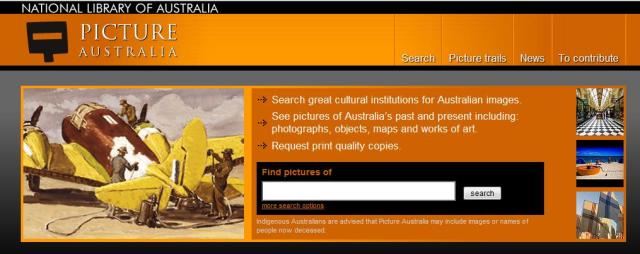The National Library of Australia (NLA) has clear links on their homepage to their blogs, Podcasts, Twitter and Facebook.
They do not have a Flickr account like the other libraries that I have discussed do, but that is probably because they have their own site for photos, called Picture Australia.
This site, which I find quite attractive, links to the online repository of the National Library, called Trove. You can search thousands of items online here, and if you have a Flickr account you can upload your own photos to the “Picture Australia” group; which is not the page that this link brings you to, strangely. Instead it brings you to an instruction site, which is useful but not the place I would have led the link to. They could have just added another link to that page.This instruction page does show how much the library appreciates contributions from anyone, and that they want to nurture a sense of online community.
The photos that are uploaded to the Flickr group will appear in the Trove repository. Pretty neat! The guide on the instruction page explains, step by step, how to do all this. If I was Australian and liked taking photos I would definitely do this.
The NLA maintains a variety of blogs, under three categories: “Behind the Scenes” “Events” and “Library Labs”. This last one is a place where the library showcases their experiments with new technologies. You can subscribe to all three categories by RSS feed, and some posts are bookmarkable through Delicious. All these blogs are written by staff members.
When looking at the “Behind the Scenes” blog I saw that they have a video up on Youtube, and it turns out that they do have a Youtube channel, even though there is no link to this on their homepage. While this makes it a lot harder to find, and you wouldn’t know about it without stumbling upon it, I actually don’t really mind this. It means that there is less of an information overload on the homepage, and that there are fewer options to choose from. In my opinion, this is usually a good thing!
When looking on Youtube, it actually turns out that they have 17 videos online, and they have 44 subscribers. So even though they have the same number of videos as the National Archives of Australia, and more followers, they didn’t feel the need to advertise this channel on their homepage. Refreshing! This is actually a better integration of tools than the separate links on the homepage would be. Adding the Youtube channel to their home page would have had no added value, and might have taken attention away from other tools that are advertised. By excluding all other image/film based tools in favour of the Picture Australia link, they have successfully drawn the visitor’s attention to that feature.
Their Twitter page is updated about once a day, and has news on events, exhibitions, and especially links to their different online resources. The same applies to their Facebook page. Additionally, on their Facebook page they have integrated RSS feeds, and link to their own ‘favourite Facebook pages’. They have also integrated their Twitter profile and Youtube channel into their Facebook profile, by using one of the applications that let you add these things to new ‘tabs’ on your profile. The fact that they have integrated Youtube into their Facebook page, but don’t mention it on their homepage is maybe a bit odd, but like I said: I like it! (Which is why I’ve ‘liked’ their profile)
The library also offers large number of Podcasts, on all different kinds of subjects. They are organized in a clear way and the page design is very appealing. I am very satisfied with the overall web design of all their webpages. They are simple, clear, and esthetically pleasing.
This really seems to be a library that has embraced Web 2.0 tools, and has integrated them into their website and various profiles with success.
You don’t feel overwhelmed here like on the Library of Congress website, even though there are a lot of options. The design of the NLA website has a lot to do with this: that they used little picture icons on their homepage, and the fact that this page is not overcrowded, is significant.
The integration of the offered Web 2.0 tools and services makes them easier to use. Their use feels more natural and less like you are doing something ‘extra’; a feeling that clumsy integration of tools can give you. People don’t want to have to put in extra effort to participate. In this case, you still have to make your own profile to participate, but for example in relation to Picture Australia, the library explains how to set up a profile and participate. The process seems easy, and fun to use, and invites active participation or at least subscription.



